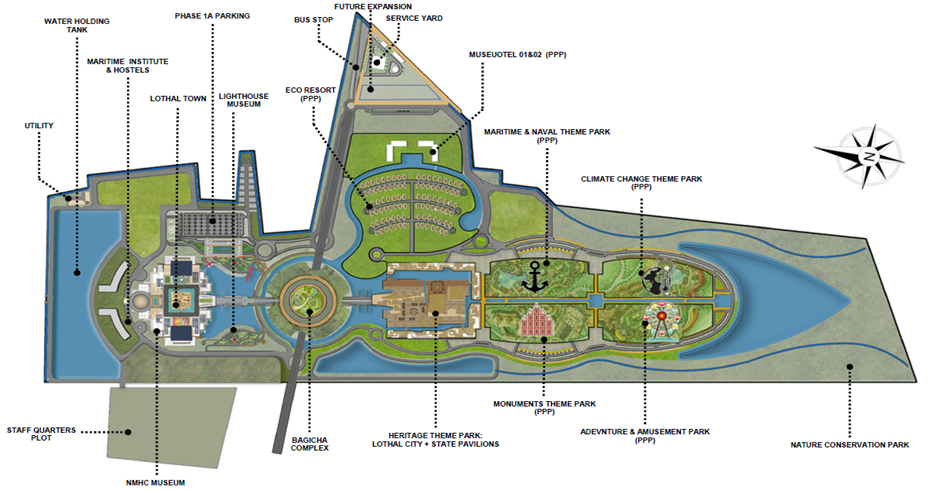Introduction
India, having 11098 km long coastline, has a rich maritime heritage and the earliest maritime evidence date backs to 5000 years.
Archaeological excavations have discovered the oldest man-made dockyard, over 5000 years old, in Lothal. Lothal is one among the prominent cities of the traditional Harappan civilization dating to 2400 BC, located in Gujarat, a crucial western state of India. The Lothal dock is one of the world’s earliest known docks. It connected the city to an ancient trade route between Harappan cities in Sindh and the peninsula of Saurashtra during the times when Kachchh was part of the Arabian Sea.
Lothal is also a significant location in terms of its diversity of culture. Being a port town, Lothal encountered and hosted many traders from different parts of the world and civilizations. Along with trade products, the cultural beliefs and values, ideas and innovative techniques were also transferred through the sea routes, making Lothal the hub of the culture and economy of the world.
In order to showcase India’s rich and diverse maritime heritage, the Ministry of Ports, Shipping and Waterways has envisioned to develop a National Maritime Heritage Complex (NMHC) at Lothal near Ahmedabad. NMHC aims at;
- Preserving and showcasing India’s Maritime Heritage
- Becoming a leading global tourist destination
- Collaborating with Coastal States & UTs
- Becoming a center for international maritime fairs and exhibitions
- Establishing international collaboration and exchange programs
- Establishing as a maritime training and research center
National Maritime Heritage Complex (NMHC) is to be the first of its kind in the country, dedicated to the legacy of maritime heritage of India.
NMHC Masterplan

The 375 Acre Masterplan of NMHC is guided by Harappan Town Planning Principles. The Citadel; situated at the highest elevated point of the site houses the most important buildings. At NMHC, the National Maritime Museum is The Citadel.The Middle Town includes the Central Bagicha and the Lower Town consists of Recreational Theme Parks, Eco resorts and Hotels / Museotel.
NMHC is being developed in a phase wise manner.
- Phase 1A (EPC mode)
- Phase 1B (EPC mode)
- Phase 2 (Land subleasing)
NMHC project components
- NMHC Museum with 14 galleries
Gallery 1: Orientation and oceanic oral traditions
Gallery 2: Harappans: The pioneer seafarers
Gallery 3: Post Harappan trajectories
Gallery 4: India’s contact with the Greco-Roman world
Gallery 5: Ancient India’s Maritime Heritage cum Special exhibitions gallery
Gallery 6: Evolution of Indian Navy and Indian Coast Guard
Gallery 7: Trade and cultural relations with Southeast Asia and beyond
Gallery 8: Maritime traditions of Gujarat
Gallery 9: Age of emporia contact
Gallery 10: Maratha Naval power
Gallery 11: Arrival of Europeans
Gallery 12: Science, Math and Tech gallery
Gallery 13: Traditional shipbuilding and navigation techniques of India
Gallery 14: Indian shipping post-independence - Lighthouse Museum
- Bageecha Complex
- Lothal town surrounded by open aquatic gallery
- Coastal State Pavilions
- Recreated Lothal City
- 4 theme-based parks
- Nature conservation park etc.
Project progress
The NMHC project has been taken up under the unique and innovative projects category of the Sagarmala programme under MoSPW. Government of Gujarat (GoG) has transferred 400 acres of land in village Saragwala on lease for 99 years to MoSPW. Renowned architect firm ‘Architect Hafeez Contractor’ has been appointed as the Principal Project Consultant to prepare master plan and project management consultancy.
Currently, the construction of Phase 1A of NMHC is in full swing, nearing completion and is being undertaken by Tata Projects Ltd. The phase 1A of the project is planned to be completed by 2025.










